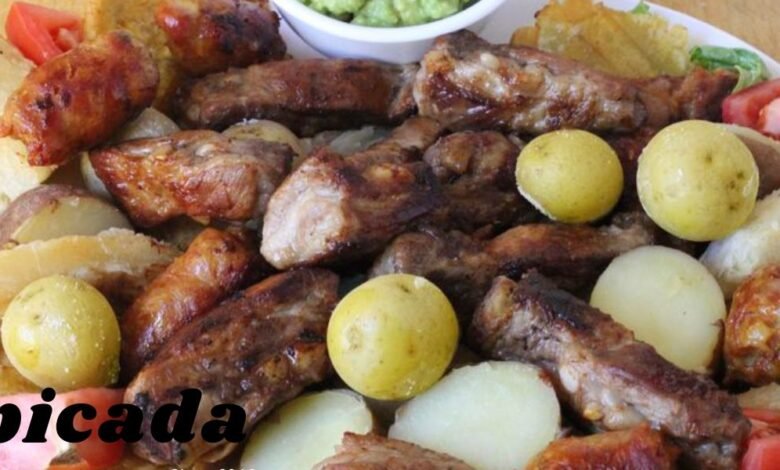picada

Are you craving a vibrant and flavorful dish that will transport your taste buds to the streets of South America? Look no further than the delectable culinary creation known as “picada.” This unique and mouthwatering dish hails from various Latin American countries, including Argentina, Uruguay, and Paraguay.
Picture this: a plate filled with an enticing assortment of cured meats, cheeses, olives, pickles, and bread. The beauty of the picada lies in its versatility – you can customize it with your favorite ingredients to create a personalized sensory experience. Whether you’re a fan of smoky chorizo, creamy provolone cheese, or tangy marinated olives, the possibilities are endless.
The beauty of picada lies not only in its incredible flavors but also in its social nature. It’s a fantastic option for sharing with friends and family, whether it’s at a casual gathering or a special occasion. The combination of diverse flavors, textures, and aromas makes picada a truly unique and enticing culinary adventure.
So, if you’re ready to tantalize your taste buds and embark on a flavor-packed journey, try a picada and discover the incredible diversity of Latin American cuisine.
What is picada?
Picada is a traditional South American dish that originated in countries such as Argentina, Uruguay, and Paraguay. It is a plate filled with an assortment of cured meats, cheeses, olives, pickles, and bread. The name “picada” comes from the Spanish word “picar,” which means “to nibble.” This perfectly describes the eating experience of picada, as it is meant to be enjoyed by picking and sampling various ingredients.
Origins of picada
The origins of picada can be traced back to the Gauchos, the nomadic horsemen of the South American Pampas. The Gauchos would often gather around a fire and share a meal, which consisted of the ingredients that are now commonly found in picadas. Over time, this communal dining experience evolved into a beloved culinary tradition that is still cherished today.
Traditional ingredients in picada
The traditional ingredients in picada vary from region to region, but there are some staples that are commonly found in this dish. Cured meats such as chorizo, salami, and ham are often included, providing a rich and savory flavor. Cheeses like provolone, manchego, and gouda add a creamy and indulgent element to the picada. Olives, pickles, and marinated vegetables provide a tangy and refreshing contrast to the richness of the meats and cheeses. And of course, no picada is complete without a variety of bread, such as baguette slices or toasted crostini.
Popular variations of picada
While the basic elements of picada remain consistent, there are numerous variations of this dish that highlight different flavors and ingredients. In Argentina, for example, picada de campo often includes grilled or roasted meats, such as beef or chicken, alongside the cured meats. In Uruguay, picada marina incorporates seafood, such as shrimp or octopus, to showcase the country’s coastal influences. Paraguay offers picada de chipa, which includes the traditional chipa bread made from manioc flour.
How to make a classic picada
Making a classic picada is relatively simple, as it involves assembling various ingredients on a plate. Start by selecting your favorite cured meats, cheeses, and olives. Arrange them on a large platter, making sure to create an enticing visual display. Add some pickles and marinated vegetables for a tangy kick. Finally, slice some fresh bread, such as baguette or ciabatta, and place it alongside the other ingredients. Serve with small plates and toothpicks to make it easy for everyone to enjoy the picada.
Serving suggestions for picada
Picada is a versatile dish that can be enjoyed in various settings. For a casual gathering, serve the picada as a centerpiece on a large table, allowing guests to help themselves. If you’re hosting a more formal event, consider plating individual servings of the picada for an elegant presentation. To enhance the experience, provide a selection of dipping sauces and spreads, such as chimichurri or aioli. And don’t forget to offer some refreshing beverages, such as crisp white wines or ice-cold beer, to complement the flavors of the picada.
Picada as a social dining experience
One of the most delightful aspects of picada is its social nature. The dish is meant to be shared and enjoyed with others, making it perfect for gatherings with friends and family. The act of picking and sampling different ingredients encourages conversation and interaction. It creates a relaxed and convivial atmosphere, where people can bond over their shared love for food and exploration of different flavors. So, invite your loved ones to join you in a picada feast and savor the joy of communal dining.
Pairing wines with picada
When it comes to pairing wines with picada, there are a few options that complement the flavors of the dish. For the rich and salty cured meats, opt for a bold red wine, such as Malbec from Argentina or Tempranillo from Spain. These wines have enough structure and tannins to stand up to the intensity of the meats. If you prefer white wine, go for a crisp and aromatic variety, such as Sauvignon Blanc or Albariño. These wines provide a refreshing contrast to the richness of the cheeses and meats. And for those who enjoy a sparkling option, a chilled glass of Prosecco or Cava adds a touch of celebration to the picada experience.
Health benefits of picada ingredients
While picada is undoubtedly a decadent and indulgent dish, it also offers some surprising health benefits. Cured meats like salami and chorizo contain protein and essential vitamins and minerals, including vitamin B12 and zinc. Cheeses provide a good source of calcium and protein, and olives are rich in heart-healthy monounsaturated fats. The pickles and marinated vegetables offer a dose of antioxidants and fiber. And let’s not forget about the bread, which provides carbohydrates for energy. So, while picada may be a treat for your taste buds, it also provides some nutritional value.
Conclusion
In conclusion, picada is a vibrant and flavorful dish that showcases the incredible diversity of Latin American cuisine. Its origins can be traced back to the Gauchos, and it has evolved into a beloved culinary tradition in countries like Argentina, Uruguay, and Paraguay. The beauty of picada lies in its versatility, allowing you to create a personalized sensory experience with your favorite ingredients. Whether enjoyed at a casual gathering or a special occasion, picada brings people together and creates memorable dining experiences. So, why not embark on a flavor-packed journey and discover the joy of picada for yourself.



